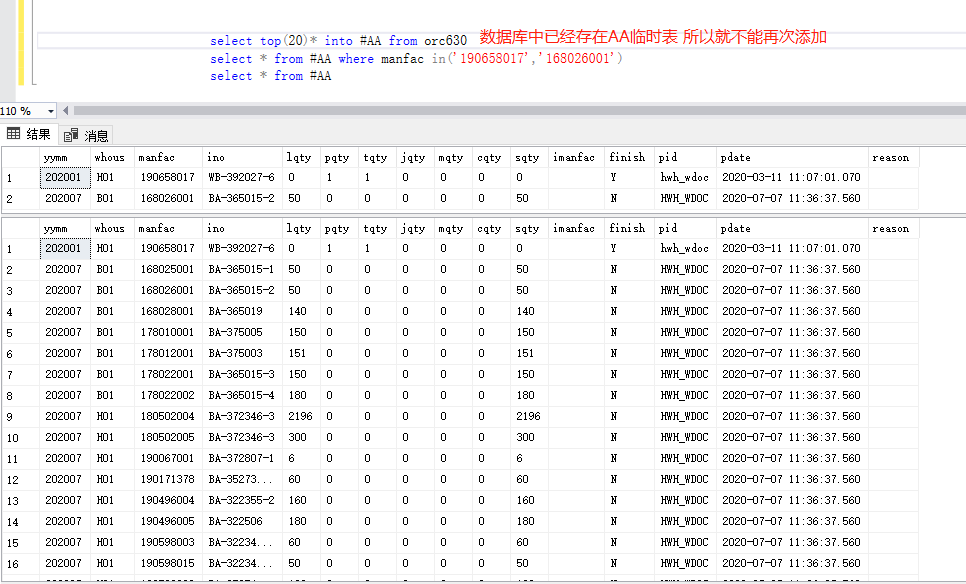记录流水账--今天同事递交了辞职申请,后续我就要接手他负责的部分工作(生管系统、材料系统)。
select top(20)* into #AA from orc630 --查询Table中的数据,并将数据加入到临时表 ‘AA’中
select * from #AA where manfac in('190658017','168026001')--通过查询临时表中指定的数据
select * from #AA --查询整个临时表的数据

-----------------------------------------------------------------------------------------下面的是引用别人的也许以后会用到---------------------------------------------
---------------------------------------------------引用的地址:https://www.cnblogs.com/sunxi/p/4501285.html---------------------------------------------------
SqlServer中把结果集放到到临时表的方法
一. SELECT INTO
1. 使用select into会自动生成临时表,不需要事先创建
select * into #temp from sysobjects
01. 把存储过程结果集SELECT INTO到临时表
select * from #temp
2. 如果当前会话中,已存在同名的临时表
select * into #temp from sysobjects
再次运行,则会报错提示:数据库中已存在名为 '%1!' 的对象。
Msg 2714, Level 16, State 6, Line 2
There is already an object named '#temp' in the database.
在使用select into前,可以先做一下判断:
if OBJECT_ID('tempdb..#temp') is not null
drop table #temp
select * into #temp from sysobjects
select * from #temp
3. 利用select into生成一个空表
如果要生成一个空的表结构,不包含任何数据,可以给定一个恒不等式如下:
select * into #temp from sysobjects where 1=2
select * from #temp
二. INSERT INTO
1. 使用insert into,需要先手动创建临时表
1.1 保存从select语句中返回的结果集
create table test_getdate(c1 datetime)
insert into test_getdate select GETDATE()
select * from test_getdate
1.2 保存从存储过程返回的结果集
create table #helpuser
UserName nvarchar(128),
RoleName nvarchar(128),
LoginName nvarchar(128),
DefDBName nvarchar(128),
DefSchemaName nvarchar(128),
UserID smallint,
SID smallint
)
insert into #helpuser exec sp_helpuser
select * from #helpuser
1.3 保存从动态语句返回的结果集
create table test_dbcc
TraceFlag varchar(100),
Status tinyint,
Global tinyint,
Session tinyint
)
insert into test_dbcc exec('DBCC TRACESTATUS')
select * from test_dbcc
对于动态SQL,或者类似DBCC这种非常规的SQL语句,都可以通过这种方式来保存结果集。
2. 不能嵌套使用insert exec语句
2.1 下面这个例子,尝试保存sp_help_job的结果集到临时表,发生错误
create table #JobInfo
job_id uniqueidentifier,
originating_server nvarchar(128),
name nvarchar(128),
enabled tinyint,
description nvarchar(512),
start_step_id int,
category nvarchar(128),
owner nvarchar(128),
notify_level_eventlog int,
notify_level_email int,
notify_level_netsend int,
notify_level_page int ,
notify_email_operator nvarchar(128),
notify_netsend_operator nvarchar(128),
notify_page_operator nvarchar(128),
delete_level int,
date_created datetime,
date_modified datetime,
version_number int,
last_run_date int,
last_run_time int,
last_run_outcome int,
next_run_date int,
next_run_time int,
next_run_schedule_id int,
current_execution_status int,
current_execution_step nvarchar(128),
current_retry_attempt int,
has_step int,
has_schedule int,
has_target int,
type int
)
insert into #JobInfo exec msdb..sp_help_job
返回错误信息:INSERT EXEC 语句不能嵌套。
Msg 8164, Level 16, State 1, Procedure sp_get_composite_job_info, Line 72
An INSERT EXEC statement cannot be nested.
展开错误信息中的存储过程:
exec sp_helptext sp_get_composite_job_info
发现里面还有个INSERT INTO…EXEC的嵌套调用,SQL Server在语法上不支持。
INSERT INTO @xp_results
EXECUTE master.dbo.xp_sqlagent_enum_jobs @can_see_all_running_jobs, @job_owner,@job_id
2.2 可以用分布式查询来避免这个问题,这种写法在INSIDE SQL Server 2005中作者提到过
(1)首先到打开服务器选项Ad Hoc Distributed Queries
exec sp_configure 'show advanced options',1
RECONFIGURE
GO
exec sp_configure 'Ad Hoc Distributed Queries',1
RECONFIGURE
GO
(2)通过OPENROWSET连接到本机,运行存储过程,取得结果集
使用windows认证
select * into #JobInfo_S1
from openrowset('sqloledb', 'server=(local);trusted_connection=yes','exec msdb.dbo.sp_help_job')
select * from #JobInfo_S1
使用SQL Server认证
SELECT * INTO #JobInfo_S2
FROM OPENROWSET('SQLOLEDB','127.0.0.1';'sa';'sa_password','exec msdb.dbo.sp_help_job')
SELECT * FROM #JobInfo_S2
这样的写法,既免去了手动建表的麻烦,也可以避免insert exec 无法嵌套的问题。几乎所有SQL语句都可以使用。
--dbcc不能直接运行
SELECT a.* into #t
FROM OPENROWSET('SQLOLEDB','127.0.0.1';'sa';'sa_password',
'dbcc log(''master'',3)') AS a
--可以变通一下
SELECT a.* into #t
FROM OPENROWSET('SQLOLEDB','127.0.0.1';'sa';'sa_password',
'exec(''DBCC LOG(''''master'''',3)'')') AS a